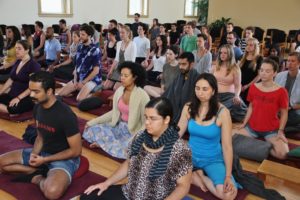
The Noble Eightfold Path with Relationships
By John M. de Castro, Ph.D.
“When we have closer intimate relationships, maybe a marital relationship or lover relationship where sexuality is involved, then we assume we want more from each other. And, there’s the rub. This is where the Buddhist idea of true love helps. True love is where you want the happiness of the beloved; it’s not that you want something from the beloved. You just want to give to the beloved. Shantideva said, “All the joy the world contains has come through wishing happiness for others. All the misery the world contains has come through wanting happiness for oneself.” – Robert Thurman
Probably the best place to practice the Eightfold Path is not on the meditation mat or in a cloistered environment but in the midst of the chaos of everyday life. There are wonderful opportunities to practice presented to us all the time embedded in the complexities of the modern world. In fact, the whole idea of practicing on the mat is to learn things that will apply to our everyday existence. What better place is there, then, than the real environment to practice them.
In previous essays, we discussed driving an automobile and the work environment as excellent venues for practice. In today’s essay we’ll discuss practicing in the midst of our relationships with significant others. This is an excellent context in which to practice the Buddha’s Eightfold Path. It is filled with emotions, desires, sex, conflicts, suffering, compassion, and memories. In other words, our relationships have all the ingredients to practice and to put to the test all the principles of mindfulness and the Eightfold Path for the cessation of suffering; Right View, Right Intentions, Right Speech, Right Actions, Right Livelihood, Right Effort, Right Mindfulness, and Right Concentration.
There are many wonderful opportunities in relationships to practice the Right View idea of impermanence. Indeed, our relationships are constantly changing. One day is full of love, understanding and kindness and the next filled with conflict, resentment, and anger. No matter how bad or good the relationships are or the daily interactions between partners, they are sure to change. Sexual relations are a wonderful example of impermanence, with desires and feeling changing dramatically from moment to moment, but none of it can be held onto for more than a moment. They come and they go. They’re impermanent. This exemplifies the Right View idea of transitoriness. We all grow and develop and change throughout our lifetime and these changes can be challenging for relationships. There’s an old story about relationships that upon marriage, the woman believes that the man will change, but he doesn’t, while the man believes that the woman will never change, but she does! Adapting and coping with these changes requires that we understand impermanence, the Right View.
We can also practice the Right View idea of interconnectedness. Relationships are cooperative ventures. How interconnected the couple is, is on display. Relationships require consideration of the needs and aspirations of both partners by both partners. Acting alone would is a sure formula for chaos and conflict in a relationship. You affect your partner and your partner affects you, which affects your partner, which, in turn, affects you and so on. If there are children involved this interconnectedness becomes magnified. Keep in mind “If you want to be happy effectively, then think about other people’s happiness and you will be. Think about your own happiness only, and you will always be dissatisfied because you will never have enough.” – Robert Thurman. Understanding and adapting to the dynamic interplay between partners requires that we recognize, adapt to, and work with this interconnectedness, the Right View.
In relationships we can also view and practice the Right View idea of no permanent self. This thing called self that you think of a permanent and static actually changes moment to moment in reaction to what transpires in relationships. How you view yourself and your beliefs about the supposed self can change in a flash depending upon what your partner says and does. You may think of yourself as a kind and loving person, but your partner treats you like a selfish and cruel person. This can change this idea of the self. A little mindful reflection regarding this reveals that this thing that we call the self was never permanent in the first place but changing and evolving, coming and going, just like everything else. The highly emotionally charged cauldron of relationships amplifies this and makes it clearer and clearer. This is a tremendous learning experience. Coming to grips with this requires that we develop the Right View of no permanent self.
It is hard to find a better context than relationships to develop the Right View idea of suffering and unsatisfactoriness, and their roots. In relationships we want everything to be exactly as we want it to be, and when it isn’t we suffer. We want our partners to understand us, we want sex to fulfill our fantasies, we want to always be agreed with, we want more excitement and less dull chores, we want our partners to acquiesce to all our decisions, we want to have space, we don’t want to deal with our in-laws, we want our partners to unconditionally love us, etc. When these things don’t happen, we suffer. In other words, you can learn, if you are observant of what is happening in relationships, that your suffering is caused by your lack of acceptance of how things really are in your relationship. So, relationships constitute wonderful laboratories to practice Right View. You can learn to accept things as they are, to see things without judgment, to view the relationship, your partner, and children just as they are, as individual human being with their own desires and needs. When you view them this way, the love grows, and the incredible wonder of life and loving begins to reveal itself. You can learn to understand that the way you act with them has consequences, affecting yourself and the rest of the family, in other words, you practice and develop Right View.
You can readily practice Right Intentions in relationships and this can lead to Right Actions. Intentions are a key. They become your moral compass. These intentions include the happiness of our partner. “True love is where you want the happiness of the beloved; it’s not that you want something from the beloved.” – Robert Thurman. They tend to lead you in the right direction even though you may at times stumble. But, it is often difficult or impossible to predict all of the consequences of your actions. Sometimes, even with the Right Intentions you can cause your partner to suffer. For example, you may want to provide a high standard of living for your partner and family and work long hours to do so. But, this may cause your partner to be lonely and unhappy or your children to feel neglected. You need to try to not only to have Right Intentions, but to discern how even the best of intentions can sometime produce harmful outcomes. The truly Right Intentions do not produce harm, only good. You have to sometimes balance the good you’re doing with the harm produced by the same actions. This requires Right View. This is where relationships can be such a great practice as you can learn what works and what doesn’t and become better at discerning what are the wholesome Right Actions from those that produce more harm than good.
Right Intentions also includes the abandonment of unwholesome desires. If you relate to your partner with anger, impatience, selfishness, resentment you are likely to harm them and yourself. The harm may not be major or direct, but indirect by affecting partner and children in negative ways. Perhaps your anger at your partner overdrawing a checking account causes you to lash out at your children. Perhaps, your selfishness causes you to neglect you partners requests or needs eliciting frustration or anger in your partner, or simply cause them to suffer. But sometimes you can produce direct harm to your partner. This can occur when anger and alcohol result in physical or psychological abuse or when your sexual desires cause you to force yourself on an unwilling partner.
On the other hand, if you practice Right Intentions with sincere intentions to create good and happiness, relieve suffering, you will treat your partner with tolerance and understanding, with kindness and good will. When our partners are treated with respect, compassion, and helpfulness or when a partner’s anger or frustration are reacted to with patience, kindness, and tolerance, harm and suffering have likely been prevented. A considerate sexual relationship, where the intentions are to love and satisfy your partner, the relationship will become more satisfying for both of you, particularly if your partner has the same Right Intentions. The happiness and love produced carries into everything that you do affecting how you treat you children, your friends, your coworkers, and everyone that you meet. It is good to reflect on the ripples of good that may have been created by the Right Actions producing positive consequences, which produce more positive consequences, producing more positive consequences, etc. well into the future. So, if you form Right Intentions and aspire to create good and happiness you’ll be a better partner and will produce more harmony and good will in in all of your interactions and more importantly will be moving yourself along the eightfold path.
There are many opportunities to practice Right Speech in relationships. This can include non-verbal communications such as facial expressions, body postures, etc., perhaps even holding hands or loving glances. But, predominantly Right Speech is verbal. You may have a bad habit of often reacting to a mistake with reflexive emotional expletives. This can occur in response to something as simple as dropping a glass of wine. This can also include gestures. These can occur reflexively or even without awareness but do no good and create harm in yourself and sometimes aggravate your partner. Keep in mind the advice “Have a fast ear and a slow tongue.” ~Mark Ward. Right Speech also involves refraining from gossip. Couples often gossip or repeat rumors about family and friends. This can hurt others in unpredictable and sometimes unknown ways. In addition, Right Speech is truthful speech. In communicating with your partner only speak things that you know are absolutely true. Even “little white lies” have a cumulative effect eroding trust and understanding, while always speaking the truth promotes trust, understanding, and harmony. Right Speech takes practice. We have years of training and daily multiple examples of wrong speech. So, be patient and practice. Slowly the effects and benefits will become apparent.
The notion of Right Livelihood mandates that the couple’s occupations not only earns a living but also creates greater happiness, wisdom, and well-being, and relieves suffering. Conversely, they should not produce harm. Some occupations can be clearly seen as creating harm such as manufacturing, selling, or delivering weapons, cigarettes, or harmful drugs, human trafficking, or driving animals to slaughter. Some occupations clearly seem to create greater good and happiness, such as teacher, aid worker, nurse, etc. But, most occupations are a little more difficult to tell. Sometimes harm is produced indirectly, such as by damaging the environment, or resulting in layoffs from a competitor, or by producing goods or services that can be misused or used by others to create harm. Although rarely having direct effects upon relationships, engaging in Right Livelihood can do so indirectly. Feeling good about what you do for work can spill over bringing those good feelings home. Also, developing the discernment required to understand the impact of your occupations is a useful skill for understanding the impact of your actions upon your partner.
Relationships also present a great context to practice Right Effort. It takes substantial effort to interact mindfully. If you act automatically as most people do most of the time, there is little or no mindfulness and little or no effort. When you first get up in the morning you have to set the intention to engage in your daily activities in such a way as to lessen suffering in yourself and your partner, to act with kindness, compassion, patience, and courtesy, to drop fear, anger, hatred, selfishness, and to bring to our interactions with our partner the intention to promote well-being and happiness. Right Effort is working the “Middle Way.” That is not trying too hard and getting stressed about interacting and loving properly, and also not being lackadaisical, but rather to try, but relax. Don’t beat yourself up when you’re not relating to your partner mindfully, but congratulate yourself when you do. The “Middle Way” is where effort should be targeted.
Acting mindlessly is probably the norm. Most people perform their routine daily activities while their minds are elsewhere, ruminating about the past, planning for the future, or off in fantasy and daydreams. This provides you with a terrific opportunity to practice Right Mindfulness. Jon Kabat-Zinn defined mindfulness as “paying attention on purpose, in the present moment, and nonjudgmentally, to the unfolding of experience moment to moment.” What better opportunity to practice this than while your interacting with your partner? Right Mindfulness precludes focusing on social media or engaging in other distractions when with your partner. Right Mindfulness makes you acutely aware of what is happening and how you’re feeling during every moment together. Awareness of how you’re feeling and what’s producing those feelings, and how you’re reacting to them makes you better able to interact effectively without emotional outbursts that are non-productive and can hurt your partner. Right Mindfulness is not just part of the eightfold path it is a prerequisite for the practice of the seven other components of the path. So, relating mindfully is a fundamental practice and relationships are great situations for practice.
Right Concentration is the practice of focusing the mind solely on one object or a specific unchanging set of objects. This is developed during contemplative practice such as meditation. It is essential to effectively interacting with you partner. Our world is replete with distractions and interruptions. But, to truly be attentive and listening mindfully to our partner we must concentrate. Right Concentration in relationships includes making the effort to be there for your partner and deeply listen to them. There are very few more important things that you can do in relationships than to simply give your partner your full presence, your full attention, your full mindfulness. Improvement in attentional ability is a consequence of practicing Right Concentration. The ability to concentrate and screen out intrusive sounds, sights, speech and thoughts allow you to focus on your partner, producing a higher quality relationship. In addition, it is thought that Right Concentration requires Right Effort, Right Intentions, and Right Mindfulness and these can also be practiced and developed. So, interacting with our beloved is a wonderful situation for the practice of Right Concentration, benefiting each partner.
Negotiating the eightfold path in relationships is not easy. But, remember that it is a practice. Over time you’ll better and better at it, but nowhere near perfect. Frequently the discursive mind takes over or your emotions will get the better of you. But, by continuing the practice you’ll slowly progress. you’ll become a better partner and have a more relaxed, loving, and happier relationship. Keep in mind the teaching that actions that lead to greater harmony and happiness should be practiced, while those that lead to unsatisfactoriness and unhappiness should be let go. One of the keys in the practice is mindfully observing your partner and yourself. This allows you to discern the improvements even when they’re small and subtle. Over time, these small improvements add up. Without doubt, practicing the eightfold path lead to a terrific, happy, satisfying, loving relationship.
“Being deeply loved by someone gives you strength, while loving someone deeply gives you courage.” ~Lao Tzu
CMCS – Center for Mindfulness and Contemplative Studies
This and other Contemplative Studies posts are also available on Google+ https://plus.google.com/106784388191201299496/posts and on Twitter @MindfulResearch









